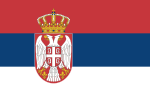| Revision as of 00:45, 3 August 2013 editAmanuensis Balkanicus (talk | contribs)Autopatrolled, Extended confirmed users28,223 edits expansion with sources← Previous edit | Revision as of 00:49, 3 August 2013 edit undoAmanuensis Balkanicus (talk | contribs)Autopatrolled, Extended confirmed users28,223 edits →History: ceNext edit → | ||
| Line 13: | Line 13: | ||
| ==History== | ==History== | ||
| ].]] | ].]] | ||
| The Šajkača is the national hat of ].{{sfn|Deliso|2009|p=97}} It is believed to have originated in the Serbian region of ] during the 18th century, when ] (Serb river troops in the service of the ]) guarded the ] and ] rivers against the ] and wore caps in the shape of an overturned ] ({{lang-sr|Шајка/Šajka}}) boat. The cap gained prominence amongst Serbs at the time of the ], when the men of Serbian revolutionary ] began discarding their Turkish ] in favour of the Šajkača.{{sfn|''Vesti Online''|30 April 2010}} | The Šajkača is the national hat of ].{{sfn|Deliso|2009|p=97}} It is believed to have originated in the Serbian region of ] during the 18th century, when ] (Serb river troops in the service of the ]) guarded the ] and ] rivers against the ] and wore caps in the shape of an overturned ] ({{lang-sr|Шајка/Šajka}}) boat. The cap gained prominence amongst Serbs at the time of the ], when the men of Serbian revolutionary ] began discarding their Turkish ] in favour of the Šajkača.{{sfn|''Vesti Online''|30 April 2010}} | ||
Revision as of 00:49, 3 August 2013
 | |
| Use | |
|---|---|
| River flotilla headgear (18th century) Military headgear (19th–20th century) National symbol (modern) | |
| Origin | |
| 18th-century Serbia. |
The Šajkača (Serbian Cyrillic: шајкача, pronounced [ʃǎjkatʃa]) is the Serbian national hat or cap.
History

The Šajkača is the national hat of Serbia. It is believed to have originated in the Serbian region of Banat during the 18th century, when Šajkaši (Serb river troops in the service of the Austrian Empire) guarded the Danube and Sava rivers against the Ottoman Turks and wore caps in the shape of an overturned Chaika (Template:Lang-sr) boat. The cap gained prominence amongst Serbs at the time of the First Serbian Uprising, when the men of Serbian revolutionary Karađorđe Petrović began discarding their Turkish fezzes in favour of the Šajkača.
The Šajkača was seen as the typical cap of peasants from the Šumadija region of Serbia, and eventually acquired a dual-purpose: during times of peace it was worn in the countryside, and in wartime it became part of the standard Serbian military uniform. During World War I, the cap was regularly worn by the soldiers of the Kingdom of Serbia. Serbia was eventually overrun by a combined Austro-Hungarian, German and Bulgarian invasion in 1915, and in 1916 the wearing of the Šajkača, alongside other Serbian folk attire, was outlawed by Bulgarian authorities in the wake of the Bulgarian occupation of southern Serbia. During World War II, the Šajkača was the standard hat worn by Serbian Chetnik irregulars in the Axis-occupied Kingdom of Yugoslavia. It was also often worn by Bosnian Serb reservists and paramilitaries during the Bosnian War of the 1990s, and was later adopted by Bosnian Serb forces to be the official headgear of the Army of Republika Srpska (VRS).
Modern use
The 1999 NATO bombing of Yugoslavia saw McDonald's chains in Serbia promote their products by distributing posters and lapels which depicted the Šajkača standing atop the golden arches of the McDonald's logo. Today, the cap is commonly seen in rural villages across Serbia, Bosnia and Herzegovina and Montenegro, often worn by elderly men.
See also
Notes
- ^ Deliso 2009, p. 97.
- Vesti Online & 30 April 2010. sfn error: no target: CITEREFVesti_Online30_April_2010 (help)
- Resić & Plewa 2002, p. 48.
- Jovanović 2000, p. 268.
- Jordan 2008, p. 20.
- Mitrović 2007, p. 224.
- Denitch 1996, p. 74.
- Taylor 2008, p. 143.
- Ungson & Wong 2008, p. 211.
References
- Deliso, Christopher (2009). "Culture and Customs of Serbia and Montenegro". Westport, Connecticut: Greenwood Publishing Group. ISBN 978-0-31334-436-7.
{{cite web}}: Invalid|ref=harv(help); Missing or empty|url=(help) - Denitch, Bogdan Denis (1996). "Ethnic Nationalism: The Tragic Death of Yugoslavia". Minneapolis, Minnesota: University of Minnesota Press. ISBN 978-0-81662-947-3.
{{cite web}}: Invalid|ref=harv(help); Missing or empty|url=(help) - Jordan, David (2008). The Balkans, Italy & Africa 1914–1918: From Sarajevo to the Piave and Lake Tanganyika. London, United Kingdom: Amber Books Ltd. ISBN 978-1-906626-14-3.
{{cite book}}: Invalid|ref=harv(help) - Jovanović, Goran (2000). "The Yugoslav War Through Cartoons". In Halpern, Joel Martin; Kideckel, David A. (eds.). Neighbors at War: Anthropological Perspectives on Yugoslav Ethnicity, Culture, and History. University Park, Pennsylvania: Penn State University Press. ISBN 978-0-27104-435-4.
{{cite book}}: Invalid|ref=harv(help) - Mitrović, Andrej (2007). Serbia's Great War, 1914–1918. London, United Kingdom: Purdue University Press. ISBN 978-1-55753-477-4.
{{cite book}}: Invalid|ref=harv(help) - Resić, Sanimir; Plewa, Barbara Törnquist (2002). "The Balkans in Focus: Cultural Boundaries in Europe". Lund, Sweden: Nordic Academic Press. ISBN 978-9-18911-638-2.
{{cite web}}: Invalid|ref=harv(help) - Taylor, Tony (2008). Denial: History Betrayed. Melbourne, Australia: Melbourne University Press. ISBN 978-0-52285-907-2.
{{cite book}}: Invalid|ref=harv(help) - Ungson, Gerardo R.; Wong, Yim-Yu (2008). Global Strategic Management. Armonk, New York: M.E. Sharpe. ISBN 978-0-76562-897-8.
{{cite book}}: Invalid|ref=harv(help)
Web
- "Šajkaču izmislili u Banatu". Vesti Online. 30 April 2010.
| Clothing | |||||||||
|---|---|---|---|---|---|---|---|---|---|
| Headwear | |||||||||
| Neckwear | |||||||||
| Underwear and lingerie |
| ||||||||
| Tops | |||||||||
| Bottoms |
| ||||||||
| Full-Body Wear |
| ||||||||
| Coats and outerwear |
| ||||||||
| Nightwear | |||||||||
| Swimwear | |||||||||
| Legwear | |||||||||
| Footwear | |||||||||
| Accessories |
| ||||||||
| Dress codes |
| ||||||||
| Related | |||||||||
